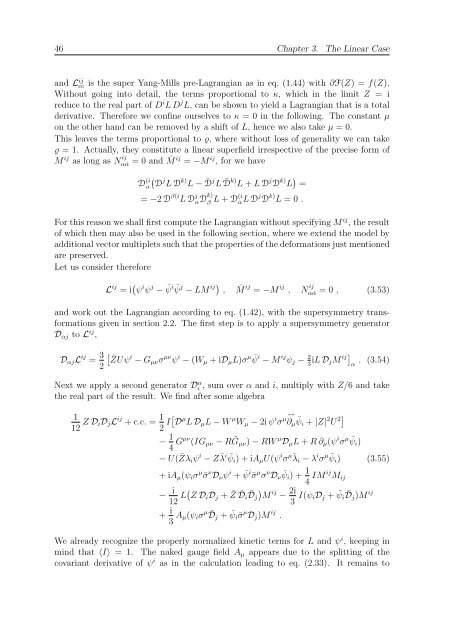N=2 Supersymmetric Gauge Theories with Nonpolynomial Interactions
N=2 Supersymmetric Gauge Theories with Nonpolynomial Interactions
N=2 Supersymmetric Gauge Theories with Nonpolynomial Interactions
Create successful ePaper yourself
Turn your PDF publications into a flip-book with our unique Google optimized e-Paper software.
46 Chapter 3. The Linear Case<br />
and L ij<br />
cc is the super Yang-Mills pre-Lagrangian as in eq. (1.44) <strong>with</strong> ∂F(Z) = f(Z).<br />
Without going into detail, the terms proportional to κ, which in the limit Z = i<br />
reduce to the real part of D i L D j L, can be shown to yield a Lagrangian that is a total<br />
derivative. Therefore we confine ourselves to κ = 0 in the following. The constant µ<br />
on the other hand can be removed by a shift of L, hence we also take µ = 0.<br />
This leaves the terms proportional to ϱ, where <strong>with</strong>out loss of generality we can take<br />
ϱ = 1. Actually, they constitute a linear superfield irrespective of the precise form of<br />
M ij as long as N ij<br />
α ˙α = 0 and ¯ M ij = −M ij , for we have<br />
D (i<br />
j k)<br />
α D L D L − D¯ j<br />
L D¯ k) j k)<br />
L + L D D L =<br />
= −2 D β(i L D j αD k)<br />
β L + D(i αL D j D k) L = 0 .<br />
For this reason we shall first compute the Lagrangian <strong>with</strong>out specifying M ij , the result<br />
of which then may also be used in the following section, where we extend the model by<br />
additional vector multiplets such that the properties of the deformations just mentioned<br />
are preserved.<br />
Let us consider therefore<br />
L ij = i ψ i ψ j − ¯ ψ i ψ¯ j ij<br />
− LM , M¯ ij ij ij<br />
= −M , Nα ˙α = 0 , (3.53)<br />
and work out the Lagrangian according to eq. (1.42), <strong>with</strong> the supersymmetry transformations<br />
given in section 2.2. The first step is to apply a supersymmetry generator<br />
Dαj to L ij ,<br />
DαjL ij = 3<br />
2<br />
<br />
¯ZUψ i<br />
− Gµνσ µν ψ i − (Wµ + iDµL)σ µ ψ¯ i ij<br />
− M ψj − 2iL<br />
DjM<br />
ij<br />
. (3.54)<br />
3 α<br />
Next we apply a second generator D α i , sum over α and i, multiply <strong>with</strong> Z/6 and take<br />
the real part of the result. We find after some algebra<br />
1<br />
12 Z DiDjL ij + c.c. = 1<br />
2 ID µ L DµL − W µ Wµ − 2i ψ i ↔<br />
µ<br />
σ ∂µ ¯ ψi + |Z| 2 U 2<br />
− 1<br />
4 Gµν (IGµν − R ˜ Gµν) − RW µ DµL + R ∂µ(ψ i σ µ ψi) ¯<br />
− U( ¯ Zλiψ i − Z¯ λ i ψi) ¯ + iAµU(ψ i σ µ¯ λi − λ i σ µ ψi) ¯ (3.55)<br />
+ iAµ(ψiσ µ ¯σ ν Dνψ i + ¯ ψ i ¯σ µ σ ν Dν ¯ ψi) + 1<br />
4 IM ij Mij<br />
− i<br />
12 LZ DiDj + ¯ Z ¯ Di ¯ ij 2i<br />
Dj M −<br />
3 I(ψiDj + ¯ ψi ¯ Dj)M ij<br />
+ i<br />
3 Aµ(ψiσ µ Dj<br />
¯ + ¯ ψi¯σ µ Dj)M ij .<br />
We already recognize the properly normalized kinetic terms for L and ψ i , keeping in<br />
mind that 〈I〉 = 1. The naked gauge field Aµ appears due to the splitting of the<br />
covariant derivative of ψ i as in the calculation leading to eq. (2.33). It remains to

















